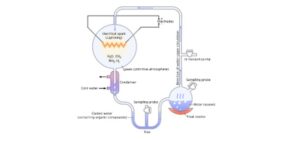Table of Contents
What is Water Cycle?
The water cycle (also known as the hydrological cycle) is the continual flow of water from the atmosphere, sea, land, and water in a continuous cycle. This constant flow of water is adequate to maintain acceptable living conditions on the globe while also transferring water to locations where it is required on a regular basis.
Entering Water Cycle
With extended, direct exposure to the sun’s heat, water in the seas evaporates, and as warm air rises above the warming ocean, droplets of water rise as cold air rushes in to cover the gap created by the rising warm air. Cloud formation is basically the elevation of water.
The wind readily moves clouds in any direction, and this driving mechanism drives the cloud in any direction as additional water evaporates from the ocean and transpires from plants and animals. The clouds, which ultimately reach high altitudes, release their water when they come into contact with the colder air.
Water Cycle Diagram

In the near future, this rainfall might wind up in a number of areas, many of which would provide favourable conditions for life to take use of it; water is a necessary component for numerous species.
Water Cycle Steps
Groundwater: Water absorbed by the earth keeps the ground moist and serves as a temporary reservoir for the water in the cycle. It finally returns to the ocean via the water table and percolation via rocks and subterranean substances.
Lakes: Lakes are formed when water is trapped in the hollows of the ground. With its vast surface area, this still water evaporates fast on hot days and can also serve as a stream feed. The freshwater ecology lesson looks at both of these forms of water ecosystems.
Surface Run-off: This water did not percolate through the earth underneath it, and in extremely rainy conditions, a huge volume of surface run-off water can collect on a slope. This water will flow downward until it reaches sea level or a stream.
Consumption: Many species on and near the surface, for example, require water as an important component of their food; in forests, a significant quantity of water is taken up by the roots of trees and other vegetation from groundwater and surface run-off. Water homeostasis is maintained in both animals and plants by diverse adaptations to suit the environment they live in.
Water Cycle Citations
- Advances in understanding large-scale responses of the water cycle to climate change. Ann N Y Acad Sci . 2020 Jul;1472(1):49-75.
- Can seawater desalination be a win-win fix to our water cycle? Water Res . 2020 Sep 1;182:115906.
- Intensification of the global water cycle and evidence from ocean salinity: a synthesis review. Ann N Y Acad Sci . 2020 Jul;1472(1):76-94.
- Figures are created with BioRender.com













